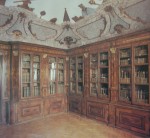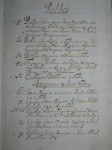 The Veszprém Episcopal Library was founded by Bishop Márton Padányi Biró. Márton Biró was the pastor of the large Veszprém diocese from 1745 to 1762. He governed his diocese from the episcopal residence he built in Sümeg.
The Veszprém Episcopal Library was founded by Bishop Márton Padányi Biró. Márton Biró was the pastor of the large Veszprém diocese from 1745 to 1762. He governed his diocese from the episcopal residence he built in Sümeg.
Former bishops – during the Turkish conquest – could not even think of a library. But libraries were not present in the times of Márton Biró either. Queen Maria Theresa instructs the episcopes to establish their own libraries. Biró is among the first ones without instructions.
After finishing his studies, his career thrives. In 1723 he is a parish priest in Bicske, in 1729 he is prebendary in Veszprém and provost in Felsőörs, in 1734 he is the vicar and most confidential colleague of Bishop Ádám Acsády, in 1740 he is a grand provost. He was a learned and literate person. Before his episcopal appointment he published 9 titles and this number was increased by 20 more during his episcopate. These stations of his vocation demanded a broad horizon. It was provided him by the books. He decided to establish a library in his palace in Sümeg. In this far-seeing job he was largely assisted by clergyman István Tessedik, his commissioner in Vienna. From November 1750, Tessedik informs Biro about the published books, their prices, the forthcoming sales and their offers. He also asks the bishop to let him know which books he would be pleased to see in his library. Biro acts accordingly. In one of his letters he even informs his commissioner about the method of sending the books. Tessedik is asked to send the books in a locked and sealed box to the Franciscans in Győr from where they are forwarded to the bailiff in Nyúl. To find haulers the best option is: The White Wolf Inn in Vienna, where the haulers from Győr usually stay. Transport to Sümeg is the responsibility of the Nyúl bailiff. Biró replies to his commissioner’s letter with pleasure every time, especially the book shipments which he itemizes in every case. He is very satisfied with his commissioner’s work and as a sign of courtesy, he sends him Somló wine.  The collection of 607 volumes were compiled shortly, and the second half of the year 1751 was the time of stock-taking. Every book has a handwritten possessor’s record in Latin. Ex libris Martini Biró de Padany episcopi Veszprimiensis, anno 1751. – From the books of Márton Padányi Biro bishop of Veszprém, 1751.
The collection of 607 volumes were compiled shortly, and the second half of the year 1751 was the time of stock-taking. Every book has a handwritten possessor’s record in Latin. Ex libris Martini Biró de Padany episcopi Veszprimiensis, anno 1751. – From the books of Márton Padányi Biro bishop of Veszprém, 1751.
The inventory lists the titles in thematic classification. Bibles are in the first place. The first item is a rarely large – rarae magnitudinis – Bible published in Lyon in 1550. The third item is a Hungarian language Bible probably the 1626 Vienna edition of Káldi’s translation. The second group includes the Bible exegeses and the works of Church Fathers. You can find here the works of St. Augustine, St. Anselm, pope St. Gregory the Great, St. Jerome, St. Thomas Aquinas and St. Gregory of Nazianzus.
These are followed by theological, ethical and legal works.
Hungarian history is also represented by a number of works. In the first place is Bonfini’s Hungarian history “Rerum Hungaricarum Decades”.
Hungarian history is followed by church history works and lastly the volumes containing homilies.
The inventory is concluded by Biró’s theological and philosophical notes. Most of the books are in Latin. There are some works in Hungarian, mostly volumes of homilies. E.g.: Homilies for festivities by István Illyés and Sunday sermons by István Landovics. The former one was published in 1708, the latter in 1689 in Nagyszombat. There is also an incunable from the 15th century: Pliny’s “Historia Naturalis” – scientific encyclopaedia. This piece was published in Venice in 1499. This talented author of the first century, according to his own confession, collected the content of his book from a large number of other works. The first part deals with the mathematical and physical description of the world. It handles the topics of Sun, Moon, stars, shooting stars, comets, solar eclipse, lunar eclipse, the Earth, the orbit and the rotation of the Earth, the seas, lakes and rivers.– This is followed by geography. Is describes the whole world known at the time: Europe, Africa, Asia. Even Pannonia and Balaton are mentioned. Then it continues with anthropology, zoology, botany and it even covers medicaments. The works listed in the inventory were located in a room next to the chapel of the episcopal residence. Biró writes to the queen that he saved money on the price of his table to be able to provide for the equipment of the episcopal library. In the following year he happily lists in his letter to the chancellor his achievements, including the Sümeg library, which is decorated with extremely stylish stucco, valuable paintings and furniture. The Sümeg library had to go without the care of the owner after Biró’s death.
